NCERT Solutions for Class 9 Science Chapter 3 Atoms and Molecules
NCERT Solutions for Class 9 Science (chemistry) Chapter 3 Atoms and Molecules are given below. In these solutions, we have answered all the intext and exercise questions provided in NCERT class 9 science textbook. Class 9 NCERT Solutions Science Chapter 3 provided in this article are strictly based on the CBSE syllabus and curriculum. Students can easily download these solutions in PDF format for free from our app.
Class 9 Science Chapter 3 Textbook Questions and Answers
Intext Questions
Page No 33
Question 1: In a reaction 5.3 g of sodium carbonate reacted with 6 g of ethanoic acid. The products were 2.2 g of carbon dioxide, 0.9g water and 8.2 g of sodium ethanoate. Show that these observations are in agreement with the law of conservation of mass.
Sodium carbonate + ethanoic acid → sodium ethanoate + carbon dioxide + water
Answer: In a reaction, sodium carbonate reacts with ethanoic acid to produce sodium ethanoate, carbon-dioxide, and water.
Sodium carbonate + ethanoic acid → sodium ethanoate + carbon dioxide + water
Mass of sodium carbonate = 5.3g (Given)
Mass of ethanoic acid = 6g (Given)
Mass of sodium ethanoate = 8.2g (Given)
Mass of carbon dioxide = 2.2 (Given)
Mass of water = 0.9g (Given)
Now, total mass before the reaction = (5.3 + 6) g = 11. 3g
and total mass after the reaction = (8.2 + 2.2 + 0.9)g = 11.3g
Therefore, Total mass before the reaction = Total mass after the reaction
Hence, the given observations are in agreement with the law of conservation of mass.
Question 2: Hydrogen and oxygen combine in the ratio of 1:8 by mass to form water. What mass of oxygen gas would be required to react completely with 3g of hydrogen gas?
Answer: It is given that the ratio of hydrogen and oxygen by mass to form water is 1:8. Then, the mass of oxygen gas required to react completely with 1g of hydrogen gas is 8g. Therefore, the mass of oxygen gas required to react completely with 3g of hydrogen gas is 8 × 3g = 24 g.
Question 3: Which postulate of Dalton’s atomic theory is the result of the law of conservation of mass?
Answer: The postulate of Dalton’s atomic theory which is a result of the law of conservation of mass is “Atoms can neither be created nor destroyed in a chemical reaction”.
Question 4: Which postulate of Dalton’s atomic theory can explain the law of definite proportions?
Answer: The postulate of Dalton’s atomic theory which can explain the law of definite proportion is “The relative number and kind of atoms in a given compound remains constant”.
Page No. 35
Question 1: Define atomic mass unit.
Answer: One atomic mass unit is equal to exactly one-twelfth (1/12th) the mass of one atom of carbon-12. The relative atomic masses of all elements have been found with respect to an atom of carbon-12.
Question 2: Why is it not possible to see an atom with naked eyes?
Answer: The size of an atom is so small that it is not possible to see it with naked eyes. Also, atom of an element does not exist independently.
Page No-39
Question 1: Write down the formula of
(i) sodium oxide
(ii) aluminium chloride
(iii) sodium sulphide
(iv) magnesium hydroxide
Answer: (i) Sodium oxide →Na2O
(ii) Aluminium chloride → AlCl3
(iii) Sodium sulphide → Na2S
(iv) Magnesium hydroxide → Mg(OH)2
Question 2: Write down the names of compounds represented by the following formula:
(i) Al2(SO4)3
(ii) CaCl2
(iii) K2SO4
(iv) KNO3
(v) CaCO3
Answer:
(i) Al2(SO4)3 → Aluminium sulphate
(ii) CaCl2 → Calcium chloride
(iii) K2SO4 → Potassium sulphate
(iv) KNO3 → Potassium nitrate
(v) CaCO3 → Calcium carbonate
Question 3: What is meant by the term chemical formula?
Answer: Chemical formula is the symbolic representation of a chemical compound. For example: The chemical formula of hydrochloric acid is HCl.
Or
The chemical formula of a compound means the symbolic representation of the composition of a compound. From the chemical formula of a compound, we can know the number and kinds of atoms of different elements that constitute the compound. For example, from the chemical formula CO2 of carbon dioxide, we come to know that one carbon atom and two oxygen atoms are chemically bonded together to form one molecule of the compound, carbon dioxide.
Question 4: How many atoms are present in a
(i) H2S molecule and
(ii) PO43- ion?
Answer: The number of atoms present are as follows:
(i) H2S molecule has 2 atoms of hydrogen and 1 atom of sulphur hence 3 atoms in totality.
(ii) PO43- ion has 1 atom of phosphorus and 4 atoms of oxygen hence 5 atoms in totality.
Page No- 40
Question 1: Calculate the molecular masses of H2, O2, Cl2, CO2, CH4, C2H6, C2H4, NH3, CH3OH.
Answer:
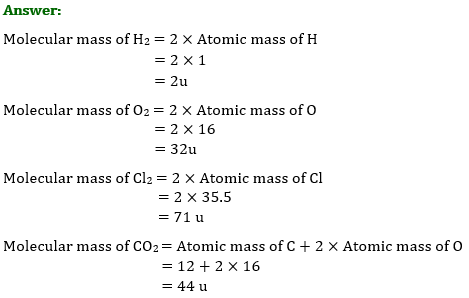
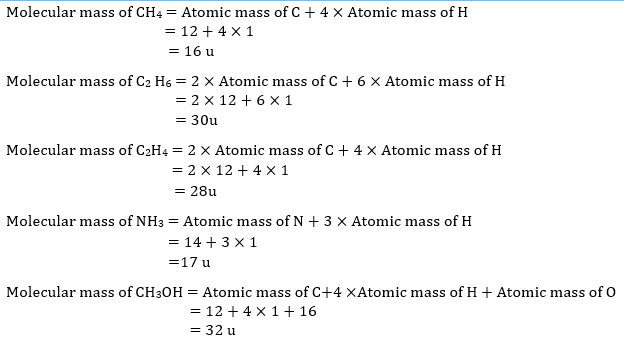
Question 2: Calculate the formula unit masses of ZnO, Na2O, K2CO3, given masses of Zn = 65u, Na = 23u, K = 39u, C = 12u, and O = 16u.
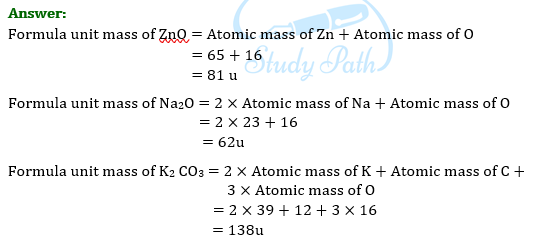
Page No. 42
Question 1: If one mole of carbon atoms weighs 12 gram, what is the mass (in gram) of 1 atom of carbon?
Answer: One mole of carbon atoms weighs 12g (Given)
i.e., mass of 1 mole of carbon atoms = 12g
Then, mass of 6.022× 1023 number of carbon atoms = 12g

Question 2: Which has more number of atoms, 100 grams of sodium or 100 grams of iron (given, atomic mass of Na = 23u, Fe = 56 u)?
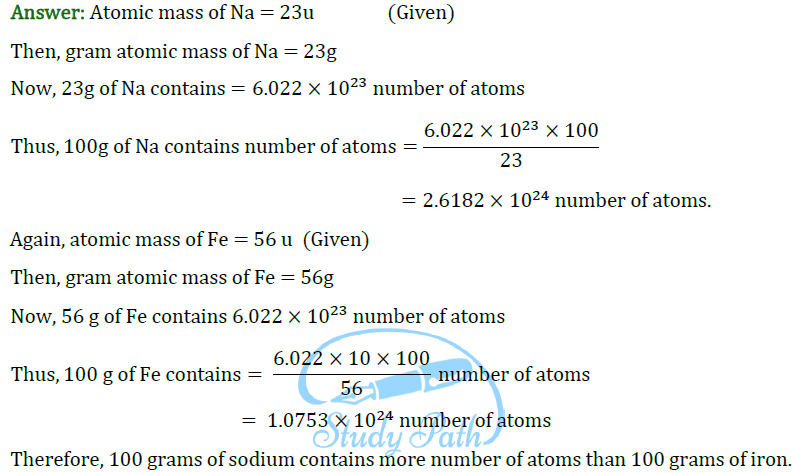
Exercises
Question 1: A 0.24 g sample of compound of oxygen and boron was found by analysis to contain 0.096 g if boron and 0.144 g of oxygen. Calculate the percentage composition of the compound by weight.
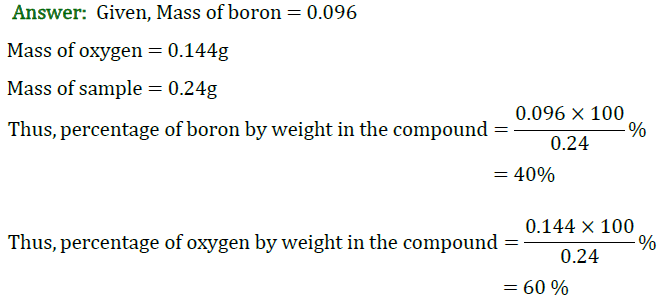
Question 2: When 3.0 g of carbon is burnt in 8.00 g oxygen, 11.00 g of carbon dioxide is produced. What mass of carbon dioxide will be formed when 3.00 g of carbon is burnt in 50.00 g of oxygen? Which law of chemical combinations will govern your answer?
Answer: Carbon + Oxygen → Carbon dioxide
3g of carbon reacts with 8 g of oxygen to produce 11g of carbon dioxide. If 3g of carbon is burnt in 50g of oxygen, then 3g of carbon will react with 8 g of oxygen. The remaining 42 g of oxygen will be left un-reactive. In this case also, only 11g of carbon dioxide will be formed. The above answer is governed by the law of constant proportions.
Question 3: What are polyatomic ions? Give examples?
Answer: Polyatomic ions are ions that contain more than one atom but they behave as a single unit
For example, ammonium ion (𝑁𝐻4+), hydroxide ion (OH−), carbonate ion (𝐶𝑂32−), Sulphate ion (𝑆𝑂42− ).
Question 4: Write the chemical formula of the following:
(a) Magnesium chloride
(b) Calcium oxide
(c) Copper nitrate
(d) Aluminium chloride
(e) Calcium carbonate
Answer: (a) Magnesium chloride → MgCl2
(b) Calcium oxide → CaO
(c) Copper nitrate → Cu (NO3)2
(d) Aluminium chloride → AlCl3
(e) Calcium carbonate → CaCO3
Question 5: Give the names of the elements present in the following compounds:
(a) Quick lime
(b) Hydrogen bromide
(c) Baking powder
(d) Potassium sulphate.

Question 6: Calculate the molar mass of the following substances:
(a) Ethyne, C2H2
(b) Sulphur molecule, S8
(c) Phosphorus molecule, P4 (atomic mass of phosphorus = 31)
(d) Hydrochloric acid, HCl
(e) Nitric acid, HNO3
Answer: (a) Molar mass of ethyne, C2H2 = 2 × 12 + 2 × 1 = 26 g
(b) Molar mass of sulphur molecule, S8 = 8 × 32 = 256 g
(c) Molar mass of phosphorus molecule, P4 = 4 × 31 = 124 g
(d) Molar mass of hydrochloric acid, HCl = 1 + 35.5 = 36.5 g
(e) Molar mass of nitric acid, HNO3 = 1 + 14 + 3 × 16 = 63 g
Question 7: What is the mass of
(a) 1 mole of nitrogen atoms?
(b) 4 moles of aluminium atoms ((Atomic mass of aluminium =27)?
(c) 10 moles of sodium sulphite (Na2SO3)?
Answer: (a) The mass of 1 mole of nitrogen atoms is 14g.
(b) The mass of 4 moles of aluminium atoms is (4 × 27)g = 108g
(c) The mass of 10 moles of sodium sulphite (Na2SO3) is
= 10 × [2 × 23 + 32 + 3 × 16] g
= 10 × [ 46 + 32 + 48]
= 10 × 126g
= 1260g
Question 8: Convert into mole.
(a) 12 g of oxygen gas
(b) 20 g of water
(c) 22 g of carbon dioxide
Answer: (a) 32 g of oxygen gas = 1 mole
Then, 12g of oxygen gas = 12/32 mole = 0.375 mole
(b) 18g of water = 1 mole
Then, 20 g of water = 20/18 mole = 1.11 moles (approx.)
(c) 44g of carbon dioxide = 1 mole
Then, 22g of carbon dioxide = 22/44 mole = 0.5 mole
Question 9: What is the mass of:
(a) 0.2 mole of oxygen atoms?
(b) 0.5 mole of water molecules?
Answer: (a) Mass of one mole of oxygen atoms = 16g
Then, mass of 0.2 mole of oxygen atoms = 0.2 × 16g = 3.2g
(b) Mass of one mole of water molecule = 18g
Then, mass of 0.5 mole of water molecules = 0.5 × 18g = 9g
Question 10: Calculate the number of molecules of sulphur (S8) present in 16g of solid sulphur.

Question 11: Calculate the number of aluminium ions present in 0.051g of aluminium oxide.
Hint: The mass of an ion is the same as that of an atom of the same element. Atomic mass of Al = 27u)
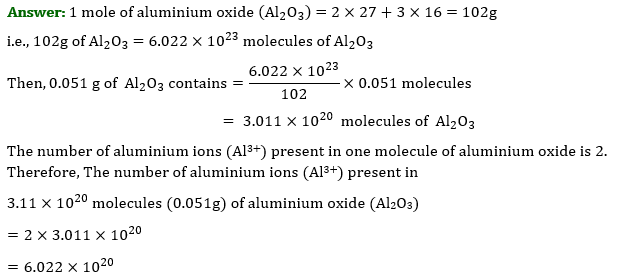
Class 9 Science NCERT Solutions Chapter 3 Atoms and Molecules
CBSE Class 9 Science NCERT Solutions Chapter 3 helps students to clear their doubts and to score good marks in the board exam. All the questions are solved by experts with a detailed explanation that will help students complete their assignments & homework. Having a good grasp over CBSE NCERT Solutions for Class 9 Science will further help the students in their preparation for board exams and other competitive exams such as NTSE, Olympiad, etc.
NCERT Solutions for Class 9 Science Chapter 3 PDF
Below we have listed the topics discussed in NCERT Solutions for Class 9 Science Chapter 3. The list gives you a quick look at the different topics and subtopics of this chapter.
| Section in NCERT Book | Topics Discussed |
|---|---|
| 3.1 | Law of Chemical Combination |
| 3.2 | What is an Atom? |
| 3.3 | What is a Molecule? |
| 3.3.3 | What is an ion? |
| 3.5 | Molecular Mass and Mole Concept |